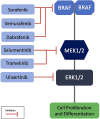Recent advances in craniopharyngioma pathophysiology and emerging therapeutic approaches
- PMID: 40433410
- PMCID: PMC12106005
- DOI: 10.3389/fendo.2025.1562942
Recent advances in craniopharyngioma pathophysiology and emerging therapeutic approaches
Abstract
Craniopharyngiomas are rare intracranial tumors originating from the Rathke's pouch, affecting the sellar and parasellar regions. Despite their benign nature, they cause significant morbidity and mortality due to their proximity to vital structures such as the optic pathways and the hypothalamic-pituitary axis, resulting in endocrine, visual, neurological impairment, and hypothalamic syndrome. Classified into adamantinomatous (ACP) and papillary (PCP), these tumors differ in epidemiology, histology, and pathophysiology. ACP, the most common type, presents a bimodal peak incidence between 5 and 15 years of age and 45 and 60 years of age, while PCP is more restricted to adults. Traditional treatments such as surgery and radiotherapy face significant challenges, including high recurrence rates. Intracystic chemotherapy is used in monocystic ACP but with limited efficacy and adverse effects related to toxicity. Recent advances in molecular biology have introduced targeted therapies, such as BRAF and MEK inhibitors, which show potential benefits in craniopharyngioma patients, particularly in the PCP. For ACP, however, therapeutic outcomes remain limited despite advances in molecular understanding, including mutations in the CTNNB1 gene and growth factors. Increasing investigation into the inflammatory microenvironment and immune response of these tumors presents new therapeutic possibilities and promising alternatives for tumor control, such as the use of anti-IL-6R, anti-VEGF agents and immune checkpoints inhibitors. This review aims to synthesize advancements in the pathophysiology of craniopharyngiomas and explore emerging therapeutic implications, focusing on precision medicine approaches for the management of this challenging disease.
Keywords: adamantinomatous craniopharyngioma; craniopharyngioma; papillary craniopharyngioma; precision medicine; target therapies.
Copyright © 2025 Pires de Oliveira Neto, Nascimento, Damianse and Faria.
Conflict of interest statement
The authors declare that the research was conducted in the absence of any commercial or financial relationships that could be construed as a potential conflict of interest.
Figures





Similar articles
-
Craniopharyngioma in Pediatrics and Adults.Adv Exp Med Biol. 2023;1405:299-329. doi: 10.1007/978-3-031-23705-8_11. Adv Exp Med Biol. 2023. PMID: 37452943
-
Diagnosis and management of craniopharyngiomas in the era of genomics and targeted therapy.Neurosurg Focus. 2016 Dec;41(6):E2. doi: 10.3171/2016.9.FOCUS16325. Neurosurg Focus. 2016. PMID: 27903124 Review.
-
Multiplexed immunofluorescence reveals potential PD-1/PD-L1 pathway vulnerabilities in craniopharyngioma.Neuro Oncol. 2018 Jul 5;20(8):1101-1112. doi: 10.1093/neuonc/noy035. Neuro Oncol. 2018. PMID: 29509940 Free PMC article.
-
Contemporary Biological Insights and Clinical Management of Craniopharyngioma.Endocr Rev. 2023 May 8;44(3):518-538. doi: 10.1210/endrev/bnac035. Endocr Rev. 2023. PMID: 36574377 Review.
-
Practical application of precision oncology in adult onset craniopharyngiomas.Front Endocrinol (Lausanne). 2024 Nov 20;15:1488958. doi: 10.3389/fendo.2024.1488958. eCollection 2024. Front Endocrinol (Lausanne). 2024. PMID: 39634188 Free PMC article. Review.
References
Publication types
MeSH terms
LinkOut - more resources
Full Text Sources
Medical
Research Materials
Miscellaneous

